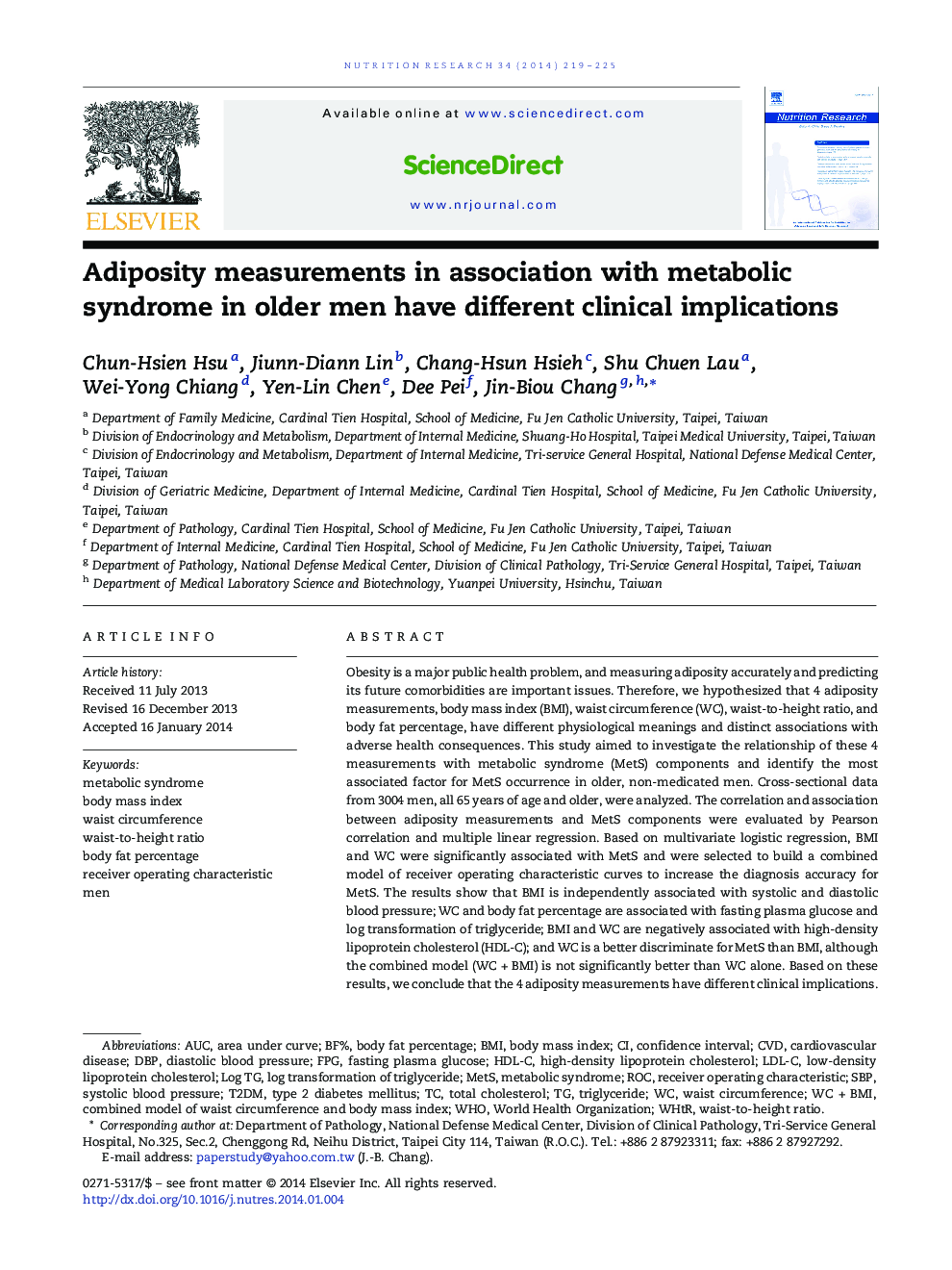| کد مقاله | کد نشریه | سال انتشار | مقاله انگلیسی | نسخه تمام متن |
|---|---|---|---|---|
| 5904450 | 1158000 | 2014 | 7 صفحه PDF | دانلود رایگان |
عنوان انگلیسی مقاله ISI
Adiposity measurements in association with metabolic syndrome in older men have different clinical implications
ترجمه فارسی عنوان
اندازه گیری های چاقی در ارتباط با سندرم متابولیک در مردان مسن با پیامدهای بالینی متفاوت است
دانلود مقاله + سفارش ترجمه
دانلود مقاله ISI انگلیسی
رایگان برای ایرانیان
کلمات کلیدی
HDL-CLDL-CFPGDBPT2DMROCSBPAUC - AUCBF% - BF٪cardiovascular disease - بیماری قلب و عروقیtriglyceride - تریگلیسریدbody fat percentage - درصد چربی بدنWaist circumference - دور کمرType 2 diabetes mellitus - دیابت نوع دوCVD - رسوب دهی شیمیایی بخار Metabolic syndrome - سندرم متابولیکbody mass index - شاخص توده بدنBMI - شاخص توده بدنیconfidence interval - فاصله اطمینانdiastolic blood pressure - فشار خون دیاستولیکsystolic blood pressure - فشار خون سیستولیکFasting plasma glucose - قند خون ناشتاhigh-density lipoprotein cholesterol - لیپوپروتئین پرچگالی یا اچدیالMETS - متسarea under curve - منطقه تحت منحنیtotal cholesterol - کلسترول تامLow-density lipoprotein cholesterol - کلسترول لیپوپروتئین با چگالی کمreceiver operating characteristic - گیرنده عامل عامل
موضوعات مرتبط
علوم زیستی و بیوفناوری
بیوشیمی، ژنتیک و زیست شناسی مولکولی
علوم غدد
چکیده انگلیسی
Obesity is a major public health problem, and measuring adiposity accurately and predicting its future comorbidities are important issues. Therefore, we hypothesized that 4 adiposity measurements, body mass index (BMI), waist circumference (WC), waist-to-height ratio, and body fat percentage, have different physiological meanings and distinct associations with adverse health consequences. This study aimed to investigate the relationship of these 4 measurements with metabolic syndrome (MetS) components and identify the most associated factor for MetS occurrence in older, non-medicated men. Cross-sectional data from 3004 men, all 65 years of age and older, were analyzed. The correlation and association between adiposity measurements and MetS components were evaluated by Pearson correlation and multiple linear regression. Based on multivariate logistic regression, BMI and WC were significantly associated with MetS and were selected to build a combined model of receiver operating characteristic curves to increase the diagnosis accuracy for MetS. The results show that BMI is independently associated with systolic and diastolic blood pressure; WC and body fat percentage are associated with fasting plasma glucose and log transformation of triglyceride; BMI and WC are negatively associated with high-density lipoprotein cholesterol (HDL-C); and WC is a better discriminate for MetS than BMI, although the combined model (WC + BMI) is not significantly better than WC alone. Based on these results, we conclude that the 4 adiposity measurements have different clinical implications. Thus, in older men, BMI is an important determinant for blood pressure and HDL-C. Waist circumference is associated with the risk of fasting plasma glucose, HDL-C, triglyceride, and MetS occurrence. The combined model did not increase the diagnosis accuracy.
ناشر
Database: Elsevier - ScienceDirect (ساینس دایرکت)
Journal: Nutrition Research - Volume 34, Issue 3, March 2014, Pages 219-225
Journal: Nutrition Research - Volume 34, Issue 3, March 2014, Pages 219-225
نویسندگان
Chun-Hsien Hsu, Jiunn-Diann Lin, Chang-Hsun Hsieh, Shu Chuen Lau, Wei-Yong Chiang, Yen-Lin Chen, Dee Pei, Jin-Biou Chang,
